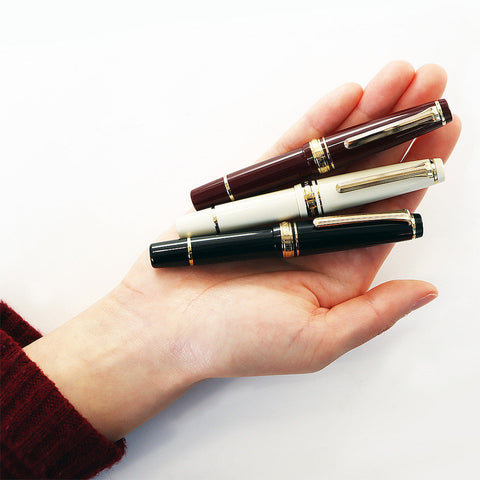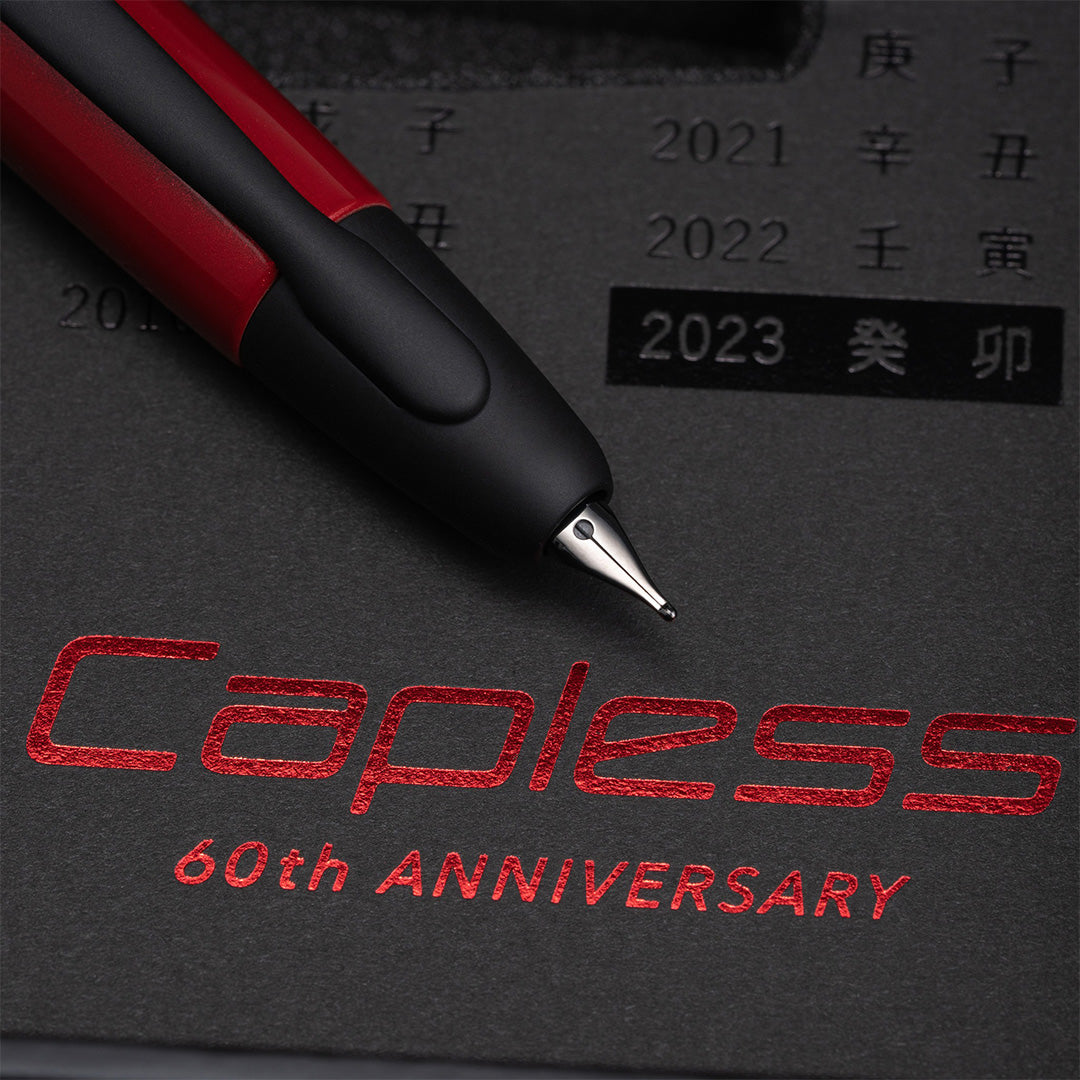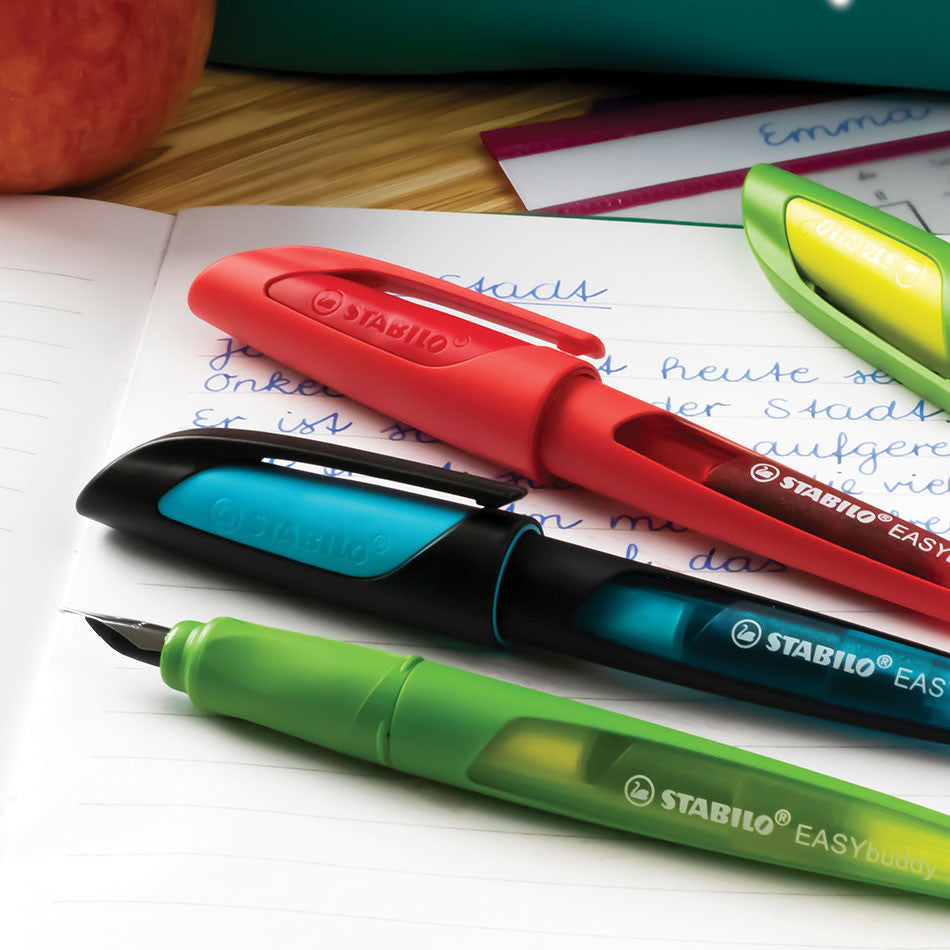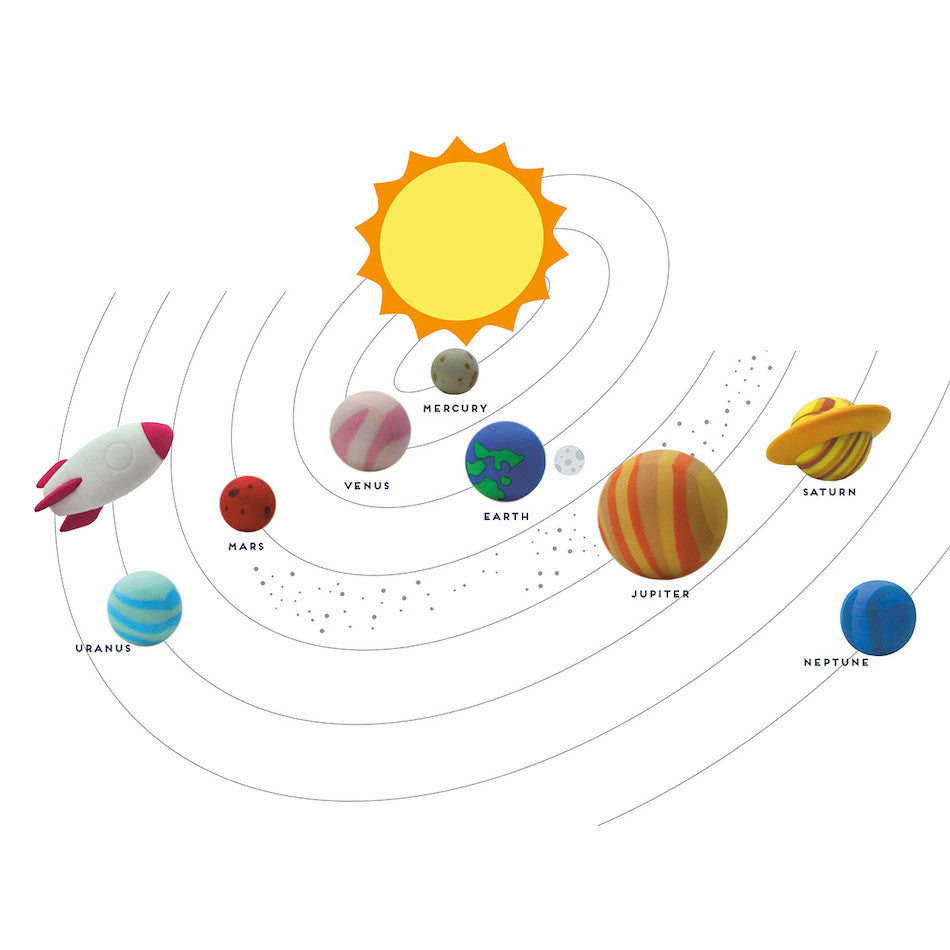Some of the Best EDC Fountain Pens
 EDC, or EveryDay Carry, is all about the things we all carry with us every day, and choosing the very best things for us. It doesn't have to be about luxury, it's more often about things that can stand up to plenty of use, and still work well and look good. Here, we look at some of the best fountain pens you can make part of your everyday carry.
EDC, or EveryDay Carry, is all about the things we all carry with us every day, and choosing the very best things for us. It doesn't have to be about luxury, it's more often about things that can stand up to plenty of use, and still work well and look good. Here, we look at some of the best fountain pens you can make part of your everyday carry.
Cult Pens Top Ten Gifts 2023
It's very hard to pick a Top 10 when you have as many products as us. But we did it. No doubt there'll be disagreements. You can't please everybody. But we've given it our best shot. So... from the top...
- Cult Pens Exclusive Sport Silver by Kaweco - subtle, silvery, semi-translucent
- Cult Pens Christmas Crackers - bangin'!
- SUCK UK Skull Desk Tidy - the best use for a skull we've found
- BENU Santa Hand-Painted fountain pen - coming soon and very limited!
- Sailor Dipton Hocoro Dip Pen Set - a fude nib to show off glitzy inks
- Pilot 60th anniversary Capless - as innovative now as it ever was - now sold out! See the rest of the Pilot Capless range.
- Derwent Inktense new colours - you can never have too many coloured pencils
- POSCA set of 54 - versatile, mark-almost-anything markers
- Caran d'Ache Keith Haring - subway art-inspired pens and pencils
- Cult Pens Ink Subscription - get a monthly ink fix!
If those didn't seem to be quite what you're looking for, we have plenty more ideas in our full Gift Guide.
The Best Inks for Calligraphy
 Yes, you can use pretty much any ink for calligraphy, just as you can use any pen. And if you just want to get started and try some calligraphy, that's the best thing to do - use whatever you have. But for the best results, it's worth getting the right ink for the job - some will be better than others for certain styles and certain pens. Here, Louise will help guide you through the world of inks for calligraphy.
Yes, you can use pretty much any ink for calligraphy, just as you can use any pen. And if you just want to get started and try some calligraphy, that's the best thing to do - use whatever you have. But for the best results, it's worth getting the right ink for the job - some will be better than others for certain styles and certain pens. Here, Louise will help guide you through the world of inks for calligraphy.
How to Clear a Mechanical Pencil Lead Jam
Not the tastiest type of jam, to be honest. This little guide is taken from our more complete and detailed Guide to Mechanical Pencils, as a quicker answer to this common question, without so much to scroll through!
If you use mechanical pencils, at some point you're likely to have a lead jam. It happens. A tiny bit of lead gets stuck somewhere in the mechanism, and stops it from working. Lead might not click forward, or it might click forward but slide back in when you try to use the pencil.
Most mechanical pencils can be dismantled to some extent to clear a jam. Usually, the part near the tip unscrews, which lets you see the mechanism. If you then push the button down against your desk, the clutch mechanism pushes up. There's a brass ring around the clutch jaws, holding them shut - push it down, and it will release the jaws. Once they've sprung open a bit of sideways tapping should dislodge any tiny bits of lead.
If the mechanism can't be opened up, blockages can usually be cleared by holding the pencil tip-up, with the button held down against your desk, and feeding a cleaning pin in through the tip to push any little bits of lead out from where they're stuck. Some pencils include a cleaning pin, usually attached to the eraser, but many don't. If you don't have one to hand, another piece of thin wire or a pin may fit, but don't force anything too wide into the tip. At a push, a spare piece of lead can do the job, but it takes a steady hand to feed it in without snapping it!
With all that done, you should be up and running again. If you're having trouble with leads snapping or jamming your pencil, and you're using cheap lead, you might find better quality lead is worth it for the extra strength then can bring. See our full range here. We'd especially recommend Pentel Ain Stein leads as being very strong and smooth.
60 Years of the Pilot Capless

A fountain pen that doesn't have a cap? A retractable fountain pen? It's unusual now, so back in the 1960s when the Capless was launched, it must have seemed really outlandish; either a case of 'it'll never catch on' (just as TV was thought to be a flash in the pan) or perhaps an assault on tradition, a bit like the newly-coined words 'selfie' and 'defo' could be seen as detrimental to the English language.
Ferris Wheel Press - Pens too, not just inks!
When they arrived on the scene, their attention to design details made Ferris Wheel Press fountain pen inks an immediate hit. The beautifully round bottles, the intricate designs on the packaging, the inspiration from a combination of fairground rides and printing presses. People loved it all.
140 Years of Kaweco
While the name ‘Kaweco’ didn’t exist until later, the story of Kaweco goes back to 1883, with the founding of the Heidelberger Federhalterfabrik, or Heidelberg fountain pen factory. A few years later, in 1889, the company was taken over by Heinrich Koch and Rudolph Weber, who used a modified version of their own initials to create the Kaweco name. The Perkeo name was also used at this time.
Jumping forward to 1911, they designed a handy pocketable fountain pen, which was the birth of the Kaweco Sport, one of their most popular pens to this day.
Guide To Derwent Inktense XL Colour Blocks
Britton Scotland - an Environmentally Conscious Enterprise
Harris Tweed® is a bit like Stilton. A woollen cloth can only be called Harris Tweed® if it's been hand-woven in the Outer Hebrides, just as a pungent blue cheese can only be called Stilton if it's been made in either Leicestershire, Nottinghamshire or Derbyshire (yes, a bit more widespread than the cloth). Our new pencil cases and pouches are a bit Stiltony too, because they are made exclusively in Scotland from Harris Tweed® (but not Stilton) by the amazing Amy and her team at Britton Scotland.

These are right in so many ways. They are made with recycled parts and they're practical, sturdy and very handsome. Not only are they primarily made from a natural material that will NEVER go out of style and is incredibly resilient, the other bits and pieces - zips, linings, labels, even the thread - have evolved from something - plastic bottles, coffee cups - that would have otherwise gone to landfill or played a plasticky part in pollution. They're made to last, and they're the way they are because they've been made by a small team of enthusiasts led by a dedicated artist and designer whose goal is to create environmentally-conscious things of beauty that reflect the remarkable country that is Scotland.

At the root of her designs is wool, specifically Harris Tweed®. It's the ideal material to enjoy Scotland's unique weather because it's water-resistant, warm in winter and cool in summer, and it has anti-microbial properties. So it's not just perfect as a woolly jumper or an overcoat (or on a sheep), it's also spot on for keeping all your everyday bits and pieces safe and dry. And the fact that it's biodegradable and recyclable fits in perfectly with Amy's objectives.
She's a woman on a mission. Making use of a sustainably-produced, locally-sourced and woven woollen cloth is only part of the story. She is terrier-like in her dedication to ensure that every other material that goes into creating her products is sourced in a way that respects the planet. 'Getting it right', not just in terms of how it's made, but what it's made from, where and how those materials were sourced, and the conditions for workers along the supply chain, is paramount. She's ably assisted in her mission by a small team of 6 flexible workers, whom she's gathered as much for the people they are, as for what they can do for Britton Scotland. It includes Pauline, her 'right- and left-hand woman', whom she relies on when it comes to production; Alexander, a business and management student who is passionate about Net Zero and is helping with carbon accounts and ESG; and Olena, a Ukrainian who's learnt to sew under Amy's tutelage and wanted a 'creative job'.
There's no mass-production at Britton Scotland; it's small batches and 'on demand' manufacturing. Multiple prototypes are a thing of the past. 'Years ago,' says Amy, 'we used to make many prototypes, which was a waste of time and resources.' So now she thinks long and hard about how a product will be manufactured, makes a single prototype, and then proceeds straight to production. And it works. 'Apart from once,' she admits! Designs are conceived with minimal waste in mind, and any offcuts go towards the development of a zero waste range. They use locally-sourced materials as much as possible and work with local suppliers, who are constantly being re-assessed for their work ethos.

Their packaging is 100% recycled and 100% recyclable. All paper is FSC-certified and 100% recyclable, and only used when necessary. The only plastic in their products has been made from recycled material.
Amy and her team have put an extraordinary amount of time and effort into making sure their products are as easy on the environment as they are easy on the eye, but are they resting on their laurels? Absolutely not. There are some interesting forthcoming projects and exciting developments, and they are preparing to apply for B Corp certification, which measures a company's entire social and environmental impact. And in the midst of all this, we're extremely grateful that she's taken the time to design some bits and pieces especially for us!
We sell pens, so we have pen pouches and pencil cases. The outers are all 100% wool while the inners are 100% wax cotton which has been rescued from going to landfill, and even the zips are 100% recycled. There's something for everybody. The pen pouches are exclusive to us, thanks to Amy and her team's combined talent. They'll keep your favourite pen as snug as anything wrapped in Harris Tweed® is likely to get (which is very). There's a slim, space-saving pencil case for a small selection of writing instruments, the sort of things you like to carry with you everyday. Or trade up for a medium-sized case, perfect for work or college. And if you're the sort of person who doesn't like to leave anything behind, make yours a large one!
Of course, it's not just pens they're good for. Art materials, make-up, glasses (of the eye kind, not the sort you put in the dishwasher), first aid items or medical necessities, your phone, money and cards... Anything that's on the small side and likely to disappear into the recesses of a cavernous bag will benefit from a Harris Tweed® Cult Pens exclusive from Britton Scotland.
It's good stuff: good to look at, good for your peace of mind and good for the planet. Thank you, Amy!

S.T. Dupont

 In 1872, innovator and photographer Simon Tissot Dupont founded S.T. Dupont, a Parisian maison dedicated to producing 'exceptional goods for exceptional people'. Initially offering leather briefcases to businessmen, he progressed to luxury travel trunks and cases coveted by the European elite, and he supplied no less than the likes of Napoleon III and Empress Eugenie. His sons Lucien and André took over in 1919, and continued the extraordinary success put in place by their father. The number of workers increased from 50 to 250, comprising craftsmen ranging from trunk- and casemakers, goldsmiths, locksmiths, engine-turners and enamellers. Simon Tissot Dupont died in 1922 and shortly afterwards his sons moved the atelier from Paris to the family's home town of Faverges at the foot of the Alps. This area, one of France's most beautiful natural environments, still influences the company's environmental and sustainability ethos today.
In 1872, innovator and photographer Simon Tissot Dupont founded S.T. Dupont, a Parisian maison dedicated to producing 'exceptional goods for exceptional people'. Initially offering leather briefcases to businessmen, he progressed to luxury travel trunks and cases coveted by the European elite, and he supplied no less than the likes of Napoleon III and Empress Eugenie. His sons Lucien and André took over in 1919, and continued the extraordinary success put in place by their father. The number of workers increased from 50 to 250, comprising craftsmen ranging from trunk- and casemakers, goldsmiths, locksmiths, engine-turners and enamellers. Simon Tissot Dupont died in 1922 and shortly afterwards his sons moved the atelier from Paris to the family's home town of Faverges at the foot of the Alps. This area, one of France's most beautiful natural environments, still influences the company's environmental and sustainability ethos today.
 By the end of the 1920s, S.T. Dupont had gained a reputation as being the foremost manufacturer of the most luxurious of luxury travel goods. And then the Wall Street crash happened. Undaunted, Lucien Tissot's reaction was to cater only to the very wealthy, reasoning that they were the least likely to have been affected by the crash. ‘Make it more beautiful,' he said. 'Make it expensive. Make it innovative.’ His extraordinarily bold decision was justified, as over the next 20 years his clients came to include Coco Chanel, John D Rockefeller and Louis Renault.
By the end of the 1920s, S.T. Dupont had gained a reputation as being the foremost manufacturer of the most luxurious of luxury travel goods. And then the Wall Street crash happened. Undaunted, Lucien Tissot's reaction was to cater only to the very wealthy, reasoning that they were the least likely to have been affected by the crash. ‘Make it more beautiful,' he said. 'Make it expensive. Make it innovative.’ His extraordinarily bold decision was justified, as over the next 20 years his clients came to include Coco Chanel, John D Rockefeller and Louis Renault.
The 1930s saw innovation in Lucien's invention of a tanning technique that used diamond powder. This lent the S.T. Dupont leather extraordinary durability whilst still remaining supple, and is still used today. With the advent of more widespread air travel luggage also had to be lighter, so the art of lacquerwork was introduced. This meant that the heavy cut-glass crystal flasks incorporated into certain travel cases could be replaced with lighter, lacquered containers which were - as a bonus - available in a multitude of colours.
In 1935 the Maharajah of Patiala ordered 100 Chinese lacquer clutch bags for the members of his harem, with each one containing a solid gold lighter. The order took S.T. Dupont three years to complete but inspired the introduction in 1941 of the world's first luxury petrol lighter. It was made of aluminium. Further research led to the creation of a gas lighter: the Ligne 1 became an instant success, coveted by the likes of Alfred Hitchcock, Pablo Picasso and Andy Warhol. Solid brass replaced the aluminium, and the designs became increasingly sophisticated.
Along with lighters, S.T. Dupont continued their innovations with luxury bags. They created the Bogie, a travel bag for Humphrey Bogart, and in 1953 André Dupont created his first ladies' handbag - the Riviera, with Audrey Hepburn being perhaps his most famous client.
 In 1971 Jackie Kennedy Onassis casually mentioned to S.T. Dupont that she'd rather like a ballpoint pen to match her personalised Ligne 1 'J' lighter, and so the team got to work. Their efforts saw the production of the company's first luxury pen, the Classique. It was made of brass, with its design influenced by the ignition roller of the Ligne 1 lighter. The Museum of Modern Art in New York even selected it for one of its exhibitions.
In 1971 Jackie Kennedy Onassis casually mentioned to S.T. Dupont that she'd rather like a ballpoint pen to match her personalised Ligne 1 'J' lighter, and so the team got to work. Their efforts saw the production of the company's first luxury pen, the Classique. It was made of brass, with its design influenced by the ignition roller of the Ligne 1 lighter. The Museum of Modern Art in New York even selected it for one of its exhibitions.
And so the S.T. Dupont maison added luxury writing instruments to its ever-expanding portfolio. The Classique was followed in the new century by the Défi line - its unique design combines a metal-injected frame with a palladium finish and carbon fibre composite body. Then came the Liberté collection with a choice of palladium or natural lacquer finishes, closely followed by the traditionally elegant Elysée. Karl Lagerfeld collaborated with S.T. Dupont in 2011 with the launch of the Mon Dupont line.

S.T. Dupont has spent over 150 years designing, innovating and recognising opportunities. They have catered to the famous, the wealthy, the influential and the controversial through speculation and without compromise. Clients have ranged from royalty - kings, maharajahs, queens and princesses, dukes and duchesses - through to entrepreneurs, designers and artists; icons, secret service agents and gangsters. In terms of luxury, they can provide it all, and will probably continue to do so well into the next century and beyond. They've weathered conflict, crashes, crises and changing fashions - in considerable style. Just like their products.
Best pens (and other stuff) for school
Wherever you are in the world, and whatever time of year it is, there's always a need for stuff for school.
Bit overwhelming though, isn't it? There are SO MANY pens. And LOTS of pencils. And pencil cases, erasers, sharpeners, rulers... OH NO!! And we haven't even factored in the 'Urgh, I don't want that!' and 'Mum! I'm not FIVE!' bit. Let's not go there. We'll leave that bit to you.
Right... so how can we help? Well, we can narrow down the search a little bit for sure. Everybody looks for different things in a bit of stationery, so we'll try and point out the factors about anything that might help you make a choice. Can't say fairer than that.

PENS
Ballpoint, rollerball or fountain pen? Oh my. Ballpoints are probably the simplest pens around. They're good for both right- and left-handers and don't really have a problem with smudging. BIC are brilliant at them. Nothing fancy, just cost-effective, reliable pens. And Staedtler's triangular-profiled triplus range makes for fatigue-free writing. Retractables are probably more practical than those with lids, because they won't leave marks where you don't want them when the lid gets lost. (Because it will, you know). Try Faber-Castell for a great, grippy choice. And if it can be refilled then so much the better.
Rollerballs offer a nice bold line and are probably better in the hand of older kids than their little brothers and sisters. Remember the Pentel R50 of your youth? With the little coloured bit on the pocket clip that you'd pull off with your teeth? Well they're still around. Pentel's JM20 is also worth considering, as is the Air from Uni-ball. For refillable ones, you can't go wrong with a LAMY, and Pentel's EnerGel is also retractable!
Fountain pens... Well, gone are the days when you had to write with one. When permanently blue fingers (and sometimes lips) were de rigueur, and when left-handed pupils despaired of ever producing anything legible. These days fountain pens are a lot more child-friendly. No need to wrestle with ink pots, just a neat packet of short ink cartridges. No necessity for heavy metal barrels: modern technology offers lightweight, ergonomic designs in bright, vivid colours. What would we recommend? How about the Pelikano from Pelikan, or STABILO's EASYbuddy? Or perhaps the LAMY abc - or the safari for older kids?

Then there's the splinter group we know as erasables, the most famous of which is probably Pilot's extensive FriXion range, which includes not just writing pens (retractable as well as capped) but pencils (no! We're joking...) fineliners, highlighters and colouring pens. Legami also do a fun range of erasables - let a llama or a koala accompany you on your error-free expeditions.
PENCILS
No self-respecting pencil case is complete without a pencil. Staedtler's red-liveried Tradition (with or without an eraser tip) and yellow-striped Noris pencils (standard or chunky) have stood the test of time; Faber-Castell's Grip range is award-winning and rightly so; and STABILO's ergonomic EASYgraph collection aimed at both right- and left-handers is second-to-none.

And what about colouring pencils? Faber-Castell have it all. There are school-friendly packs of 12, fat-barrelled pencils for little fingers and brilliant bicolours: 16 colours for the price of 8! And Crayola are kings of the wild frontier that is Key Stage 1.
OTHER STUFF
Pens and pencils are perfect, but all educatees need a few other bits and bobs to round out the arsenal. Take sharpeners. A pencil would be blunt without one. There are lots of pleasingly hefty metal offerings from KUM and M+R, ideal for older kids, and those that come equipped with tubs are brilliant - safer for younger fingers, less likely to get lost and less messy too. And why not try one made from recycled material? Or a Maped one shaped like a bee or a bunny?
There is an astonishingly large number of erasers out there, and they only do one thing! How can there be so many? Who knows? There just are. You can stick to the traditional offerings from Staedtler, Faber-Castell and Tombow MONO, or indulge the Legami beast that is Fashion. Just because it's shaped like Saturn or smells like a unicorn (what do they smell like?) doesn't mean it won't rub stuff out.

Rulers (or 'rules' if we're going to be precise about these things. Which we are, but this is school we're talking about, not engineering) can be problematic. A 30cm one is perfect - Staedtler's a good bet, and Maped have an unbreakable one! - but it won't actually fit in a pencil case (unless you have an extra-large one. And then you'd need an extra-large school bag. Combine that with having to wear your big brother's cast-off uniform and we're looking at a very unwieldy start to the school year). A 15cm one will fit, and for many applications it'll be completely fine. There are some great ones from KUM, including the SoftieFlex and a wavy one (it's got a straight edge too). But the ultimate is a 30cm ruler that folds in half. So you get the best of both worlds.
Highlighters highlight. And some, like Zebra, lowlight (or 'mildlight'). Some - STABILO's BOSS springs to mind - have a traditional chunky look about them, while others are shaped like a normal pen, like those from BIC. Some aren't pens at all - they're pencils! Those from edding are very wee, and some don't look like highlighters at all (that would be Legami). But all of them make individual words or whole passages stand out, so your choice is really based on what it looks like rather than what it does!
Pencil cases are a must. How else are the kids going to stash their stuff? Do they like to be organised, with a place for everything and a everything in its place? Or are they a happy rummager - the junior version of the adult who tips their bag upside down in an effort to find a pen? No matter which way they work, there's plenty of choice. Lihit Lab do a great line in quirky pen storage, and some double as pen pots (which can make for a happy medium between the super-organised and the wing-it brigades). Helix cover all bases, from transparent to camouflage, and there's a huge range of colour choices from Rhodia.
 />
/>
Best pens (and other stuff) for teachers
Schools don't just have children in them though. Oh no. They have teachers too. Because what would a school be without its teachers? A building with kids and dinner ladies in it, that's what. Anarchy. And that's just the dinner ladies. Anyway, teachers need pens too. And different sorts. And different colours! Best for the kids to stick to blue, or maybe black, but the teachers get a slightly more colourful palette. Why? Well, they have to mark things (preferably with a tick and a Good! rather than a cross and No!) and their remarks have to stand out.
Purple and green and orange seem to be the colours of choice. And thankfully there are plenty to choose from. Not so many that it makes brains melt but enough to suit individual writing styles. Schneider are particularly good at offering a wide colour range, and their pens - both ballpoints and rollerballs - are super-smooth. They're also highly environmentally-conscious when it comes to manufacturing. It might be that a fineliner is called for, in which case the colour spectrum is vast! Try the triplus 334 from Staedtler or the point 88 from STABILO.

Whiteboard markers are what the kids would really like to get their hands on - big board, big pen, big scribbles! But no. They're for teachers. And Pilot's V Board Master is top of the class! Not only are the markers made from 91% recycled plastic, they're refillable using cartridges that are made from 100% recycled plastic. Oh, and there are 4 tip sizes to choose from as well.
Sticky notes are useful too. Go for the plain and practical with Post-its, or teachers, too, can liberate their inner odd person with Legami.
And rulers (or rules)? Now that recalcitrant children don't get rapped over the knuckles with them, there's no need.
